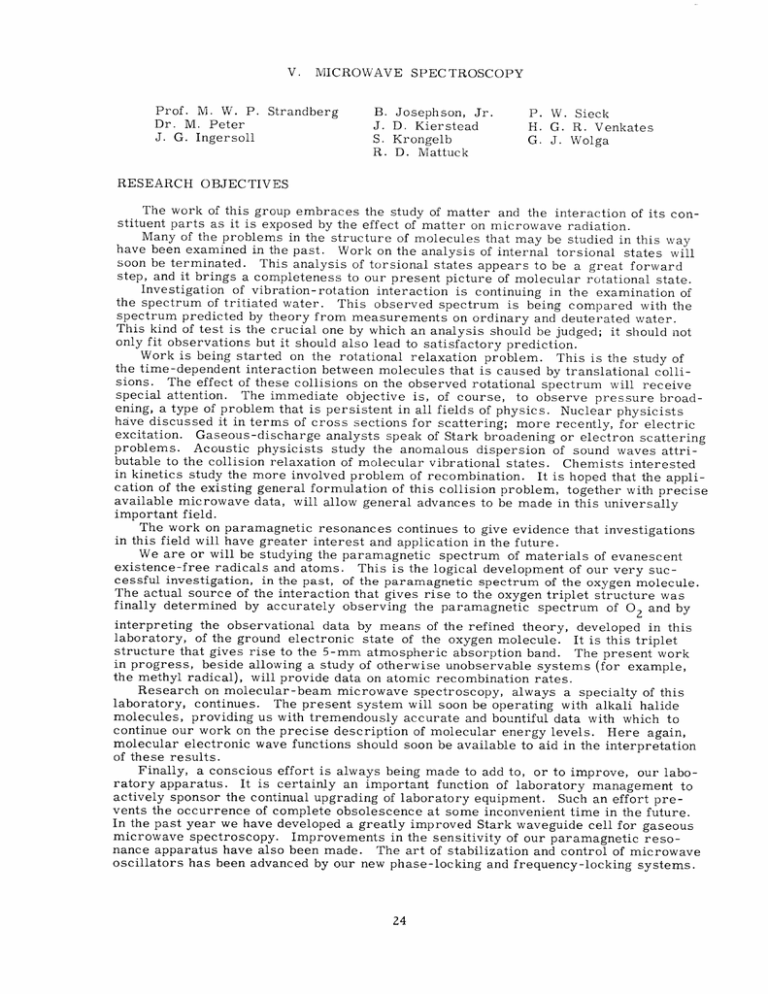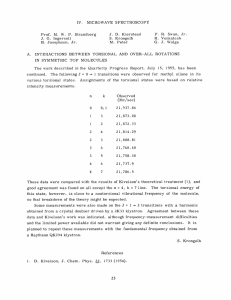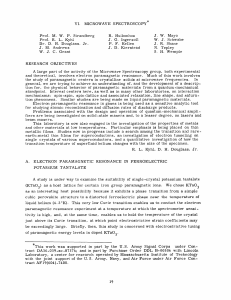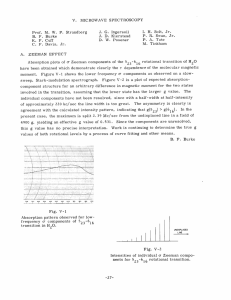V. MICROWAVE SPECTROSCOPY B. Josephson, Jr.
advertisement

V. Prof. M. W. P. Dr. M. Peter J. G. Ingersoll MICROWAVE SPECTROSCOPY Strandberg B. J. S. R. Josephson, Jr. D. Kierstead Krongelb D. Mattuck P. W. Sieck H. G. R. Venkates G. J. Wolga RESEARCH OBJECTIVES The work of this group embraces the study of matter and the interaction of its constituent parts as it is exposed by the effect of matter on microwave radiation. Many of the problems in the structure of molecules that may be studied in this way have been examined in the past. Work on the analysis of internal torsional states will soon be terminated. This analysis of torsional states appears to be a great forward step, and it brings a completeness to our present picture of molecular rotational state. Investigation of vibration-rotation interaction is continuing in the examination of the spectrum of tritiated water. This observed spectrum is being compared with the spectrum predicted by theory from measurements on ordinary and deuterated water. This kind of test is the crucial one by which an analysis should be judged; it should not only fit observations but it should also lead to satisfactory prediction. Work is being started on the rotational relaxation problem. This is the study of the time-dependent interaction between molecules that is caused by translational collisions. The effect of these collisions on the observed rotational spectrum will receive special attention. The immediate objective is, of course, to observe pressure broadening, a type of problem that is persistent in all fields of physics. Nuclear physicists have discussed it in terms of cross sections for scattering; more recently, for electric excitation. Gaseous-discharge analysts speak of Stark broadening or electron scattering problems. Acoustic physicists study the anomalous dispersion of sound waves attributable to the collision relaxation of molecular vibrational states. Chemists interested in kinetics study the more involved problem of recombination. It is hoped that the application of the existing general formulation of this collision problem, together with precise available microwave data, will allow general advances to be made in this universally important field. The work on paramagnetic resonances continues to give evidence that investigations in this field will have greater interest and application in the future. We are or will be studying the paramagnetic spectrum of materials of evanescent existence-free radicals and atoms. This is the logical development of our very successful investigation, in the past, of the paramagnetic spectrum of the oxygen molecule. The actual source of the interaction that gives rise to the oxygen triplet structure was finally determined by accurately observing the paramagnetic spectrum of 02 and by interpreting the observational data by means of the refined theory, developed in this laboratory, of the ground electronic state of the oxygen molecule. It is this triplet structure that gives rise to the 5-mm atmospheric absorption band. The present work in progress, beside allowing a study of otherwise unobservable systems (for example, the methyl radical), will provide data on atomic recombination rates. Research on molecular-beam microwave spectroscopy, always a specialty of this laboratory, continues. The present system will soon be operating with alkali halide molecules, providing us with tremendously accurate and bountiful data with which to continue our work on the precise description of molecular energy levels. Here again, molecular electronic wave functions should soon be available to aid in the interpretation of these results. Finally, a conscious effort is always being made to add to, or to improve, our laboratory apparatus. It is certainly an important function of laboratory management to actively sponsor the continual upgrading of laboratory equipment. Such an effort prevents the occurrence of complete obsolescence at some inconvenient time in the future. In the past year we have developed a greatly improved Stark waveguide cell for gaseous microwave spectroscopy. Improvements in the sensitivity of our paramagnetic resonance apparatus have also been made. The art of stabilization and control of microwave oscillators has been advanced by our new phase-locking and frequency-locking systems. MICROWAVE SPECTROSCOPY) (V. We shall make special effort to devise better and simpler microwave-frequency measuring apparatus. Studies will be undertaken on quartz secondary-frequency standards, the operation of harmonic converters in the microwave region, and the development of simple multiplier chains and reliable high-speed counters. Research of this kind is never started until we are certain that definite improvement can be made. For example, the laboratory has long needed an absolute absorption meter to measure absolute gaseous absorption. We now have a promising device (already named the "micromodulator") which is being built to fill this need. M. %%.P. A. Strandberg MOTION IN ELECTROSTATIC FIELDS MOLECULAR The energy of an electrical dipole of moment [. in a field E is W = 4E cos 0. If [ is induced by the field, i = aE cos 0, a being the polarizability. A polarizable 2 2 particle then experiences a force, F = W = a cos 0 VE . The paths of polarizable particles traveling through various electrostatic-field configurations have been studied. The fields were assumed to be generated by rods between infinite parallel plates. In the case shown in Fig. V-lb, for instance, the force is determined by a potential U 12 a2 dipole 2 cos 2 x • sinh cosh 2 +[cos ] -y 2 sin -y L 3 ) cosh - sin y) where the electric potential sinh 4 x cos 2 2 dipole = cosh Lx In Fig. V-la, plates, y - cos L the deflection angle imposed on a trajectory parallel to the grounded if the particle travels from x = 2 y) 2 o 2 2 L 2coso y L to x = +o, -c cos- L2 sin y- 2 is (for small angles) sinL-y L L where and W cosh x + cos y cosh - x - cos- y is the kinetic energy of the particle. The NH 3 molecule furnishes an example of polarizable particles. The value of (V. MICROWAVE SPECTROSCOPY) 00 (a) Fig. V-i. (b) Electrostatic focusing fields. a cos2 0 depends on the various internal degrees of freedom (1) but it is found that the described configurations and combinations thereof make effective cylindrical lenses, particularly if it is taken into account that for stronger fields a itself depends on E. Mi. Peter References 1. J. B. M. Jauch, Phys. Rev. 72, 715 (1947). WEAK-FIELD ZEEMAN EFFECT IN N 14 H3 A comprehensive treatment of the zero-field spectrum of N14H3 has been given by Gunther-Mohr, Townes, and Van Vleck (1) and by Gordon (2). Their calculations, based on a coupling scheme corresponding to successive additions of rotational momentum J, nitrogen spin I n , and spin of the three protons I, yield J + In = Fl; FI + I = F. If a field H z is applied that is weak compared to the magnetic coupling of the protons in N H 3 , the degeneracy with respect to the magnetic quantum number M F is removed, and each level splits into 2F + 1 sublevels W For J = 3, + AW. and K = 3, 0.48, g, = 5.4, I 1 the pertinent constants have these values: = 1, I = 3/2. For a--components the selection rules are: AI = 0; A J = 0, +1, AM F gN = 0. 40, gM = +1; AF = +1, 0; AF = +10; giving rise to 84 energy levels. The intensities of the transitions are known from the intensities of the unsplit lines and the known MF dependence of the dipole elements. The splitting caused by the hydrogen magnetic interaction with molecular rotation measured by Gordon is 60 kc/sec. The effective g-factor is Igeff I< 4.6 kc/sec/gauss. Hence we find that for fields of approximately 10 gauss and splittings of approximately 60 kc/sec, the hydrogen interaction will be quenched and so, with spectroscopes used in the past, this Zeeman effect was not observable. Measurements of this effect are planned with the molecular-beam microwave spectroscope. The value of geff indicates a possible 1 kc/sec splitting of the N14H 3 3-3 line in the earth's magnetic field. M. Peter (V. MICROWAVE SPECTROSCOPY) References 1. 2. C. H. Townes, and J. the spectrum of N14H 3 . Theoretical discussion, Phys. Rev. 94, Gordon, Hyperfine structure in the inversion spectrum of N 14H P. J. II. high-resolution microwave spectrometer, C. H. Van Vleck, Hyperfine structure in G. R. Gunther-Mohr, Phys. Rev. 99, 1191 (1954). 3 by a new 1253 (1955). A SIMPLE FREQUENCY DISCRIMINATOR The circuit shown in Fig. V-2 makes a very simple discriminator of essentially constant peak-to-peak width and easily adjustable center frequency. In a simple analysis, the detector crystals X l , X 2 may be replaced by Ceq. The input is connected to a dc grounded source whose impedance is high compared to For example, l/wC eq. the input might be connected to the output of a double-tuned The capacitors C 3 , C 4 , and C filter. 5 are large rf admittances. The input is then divided between two impedances. Z1 If w = I1 iwC eq 2 then Z2 = oo, l,' shown in Fig. V-3. i 1= + 2 iC2C eq C( 1 2 2 and the current i flows entirely in X 1 , creating the positive peak The negative peak appears when i is flowing entirely through X 2 ; when Z 2 ( w 2 ) = 0; from which we find that is, 2 1 1 (LC) w 1/2 eq 2C Ceq INPUT UTPUT T 1 Z' II SI Ceq Ce Fig. V-2. Discriminator. (V. MICROWAVE SPECTROSCOPY) VOUT I +2 -+1 0 -- 2 Fig. V-3. If necessary, C e Discriminator characteristic. might be changed by adding a parallel capacitor. nator, working at wj1 2 This discrimi- = 20 Mc/sec has been used successfully in an afc system that we designed recently for the stabilization of klystron sources. M. D. Peter TRAVELING-WAVE CAVITY Microwave spectroscopy can be carried on by observing the absorption of a wave traveling through a waveguide, or by observing a standing wave in a cavity. Both methods have advantages. In a cavity, a large amount of electromagnetic energy interacts with the substance under observation even if little input power is available, because of an energy step-up proportional to the Q-factor of the cavity. In addition, cavities are of smaller size than waveguides. On the other hand, the use of waveguides concedes the application of homogeneous electric fields for measurements of the Stark effect. polarization are found in a traveling wave. Also, points of pure circular It is therefore of interest to analyze a circuit that permits the step-up of the power level of a wave traveling through a waveguide. A circuit of this kind is shown in Fig. V-4. Through an x-db directional coupler, a fraction P /Q = 10-10x P is coupled into the circuit with the absorption cell. of the input power The phase-shifter and attenuator are then adjusted in such a way that power in the circuit builds up to a level Q Po. A fraction Po will then be coupled back through the directional coupler and will interfere destructively with the input signal so that zero output, is produced, thus presenting us with a bridge spectroscope. An analysis of this circuit based on an analog circuit for a quarter-wave branchedguide directional coupler (1) shows that the signal power from the Stark modulated bridge (V. MICROWAVE SPECTROSCOPY) MICROWAVE ABSORPTION INPUT OUTPUT BRANCHED Fig. V-4. GUIDE COUPLER Traveling-wave cavity. equals the power that we would get from a conventional Stark modulated cell of the same dimensions, operated with the same energy in the cell. The advantages of the new cir- cuit are the low input power required and the fact that the unused power is bridged out from the output. M. Peter References i. R. J. Harrison, Design considerations for directional couplers, Report 724, Radiation Laboratory, M.I.T., Dec. 31, 1945. E. PARAMAGNETIC RESONANCE Work is nearly completed on converting the paramagnetic resonance spectrograph for high-frequency modulation. The revised system will be used to investigate paramagnetic substances in the solid and gaseous states. G. J. Wolga





